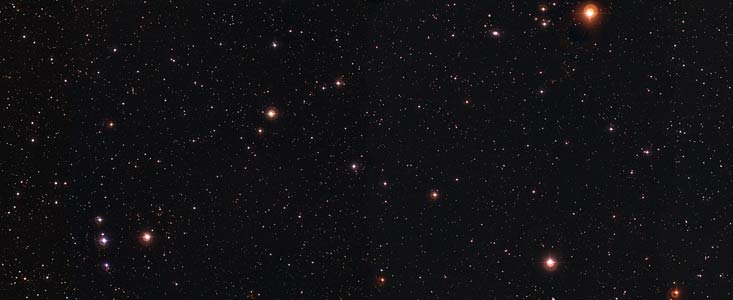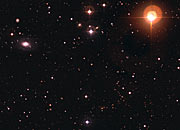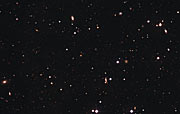Communiqué de presse
The Great Easter Egg Hunt: The Void's Incredible Richness
Huge Astronomical Image of 'Empty Space' Obtained with ESO Telescope
14 avril 2006
An image made of about 300 million pixels is being released by ESO, based on more than 64 hours of observations with the Wide-Field Camera on the 2.2m telescope at La Silla (Chile). The image covers an 'empty' region of the sky five times the size of the full moon, opening an exceptionally clear view towards the most distant part of our universe. It reveals objects that are 100 million times fainter than what the unaided eye can see.
Easter is in many countries a time of great excitement for children who are on the big hunt for chocolate eggs, hidden all about the places. Astronomers, however, do not need to wait this special day to get such an excitement: it is indeed daily that they look for faraway objects concealed in deep images of the sky. And as with chocolate eggs, deep sky objects, such as galaxies, quasars or gravitational lenses, come in the wildest variety of colours and shapes.
The image presented here is one of such very deep image of the sky. It is the combination of 714 frames for a total exposure time of 64.5 hours obtained through four different filters (B, V, R, and I)! It consists of four adjacent Wide-Field Camera pointings (each 33x34 arcmin), covering a total area larger than one square degree.
Yet, if you were to look at this large portion of the firmament with the unaided eye, you would just see... nothing. The area, named Deep 3, was indeed chosen to be a random but empty, high galactic latitude field, positioned in such a way that it can be observed from the La Silla observatory all over the year.
Together with two other regions, Deep 1 and Deep 2, Deep 3 is part of the Deep Public Survey (DPS), based on ideas submitted by the ESO community and covering a total sky area of 3 square degrees. Deep 1 and Deep 2 were selected because they overlapped with regions of other scientific interest. For instance, Deep 1 was chosen to complement the deep ATESP radio survey carried out with the Australia Telescope Compact Array (ATCA) covering the region surveyed by the ESO Slice Project, while Deep 2 included the CDF-S field. Each region is observed in the optical, with the WFI, and in the near-infrared, with SOFI on the 3.5-m New Technology Telescope also at La Silla.
Deep 3 is located in the Crater ('The Cup'), a southern constellation with very little interest (the brightest star is of fourth magnitude, i.e. only a factor six brighter than what a keen observer can see with the unaided eye), in between the Virgo, Corvus and Hydra constellations. Such comparatively empty fields provide an unusually clear view towards the distant regions in the Universe and thus open a window towards the earliest cosmic times. The deep imaging data can for example be used to pre-select objects by colour for follow-up spectroscopy with ESO's Very Large Telescope instruments.
But being empty is only a relative notion. True, on the whole image, the SIMBAD Astronomical database references less than 50 objects, clearly a tiny number compared to the myriad of anonymous stars and galaxies that can be seen in the deep image obtained by the Survey!
Among the objects catalogued is the galaxy visible in the top middle right (see also ESO Press Photo eso0614) and named ESO 570-19. Located 60 million light-years away, this spiral galaxy is the largest in the image. It is located not so far - on the image! - from the brightest star in the field, UW Crateris. This red giant is a variable star that is about 8 times fainter than what the unaided eye can see. The second and third brightest stars in this image are visible in the lower far right and in the lower middle left. The first is a star slightly more massive than the Sun, HD 98081, while the other is another red giant, HD 98507.
In the image, a vast number of stars and galaxies are to be studied and compared. They come in a variety of colours and the stars form amazing asterisms (a group of stars forming a pattern), while the galaxies, which are to be counted by the tens of thousands come in different shapes and some even interact or form part of a cluster.
The image and the other associated data will certainly provide a plethora of new results in the years to come. In the meantime, why don't you explore the image with the zoom-in facility, and start your own journey into infinity? Just be careful not to get lost. And remember: don't eat too many of these chocolate eggs!
High resolution images and their captions are available on this page.
Notes
The ESO Deep-Public-Survey (DPS) is a multi-colour imaging survey carried out by the ESO Imaging Survey (EIS) team and consists of data taken in UBVRI-bands taken with the Wide Field Imager (WFI) at the 2.2m telescope at La Silla and infrared data in the J- and Ks-bands observed with SOFI at the New Technology Telescope, also at La Silla. The main scientific drivers for the ESO DPS are searches for high-redshift galaxies, distant clusters, high-redshift quasars, low surface-brightness galaxies, and gravitational lensing studies. The survey was designed in a way to deliver a unique dataset also for studies on Galactic structure, very low-metallicity stars, white dwarfs, M-dwarfs, and field brown dwarfs.
The image is based on data processed by the GaBoDS team, a German collaboration led by the Argelander Institut für Astronomie (AIfA), using a specific reduction pipeline, THELI. The team released 63 reduced, photometrically and astrometrically fully calibrated, and stacked images of the optical part. The data are presented in the paper 'GaBoDS: The Garching-Bonn Deep Survey V. Data release of the ESO Deep-Public-Survey' by Hendrik Hildebrandt et al. to be published in Astronomy and Astrophysics and available at astro-ph/0509882. Some of these data, covering the Deep 3 field in the B, V, R, and I-bands, were combined in a colour image by Hännes Heyer and Olivia Blanchemain (ESO).
A propos du communiqué de presse
| Communiqué de presse N°: | eso0614 |
| Legacy ID: | PR 14/06 |
| Nom: | DPS Deep 3 Field, ESO 570-19, UW Crateris |
| Type: | Early Universe : Galaxy : Grouping : Cluster |
| Facility: | MPG/ESO 2.2-metre telescope, New Technology Telescope |
| Instruments: | SOFI, WFI |
Our use of Cookies
We use cookies that are essential for accessing our websites and using our services. We also use cookies to analyse, measure and improve our websites’ performance, to enable content sharing via social media and to display media content hosted on third-party platforms.
ESO Cookies Policy
The European Organisation for Astronomical Research in the Southern Hemisphere (ESO) is the pre-eminent intergovernmental science and technology organisation in astronomy. It carries out an ambitious programme focused on the design, construction and operation of powerful ground-based observing facilities for astronomy.
This Cookies Policy is intended to provide clarity by outlining the cookies used on the ESO public websites, their functions, the options you have for controlling them, and the ways you can contact us for additional details.
What are cookies?
Cookies are small pieces of data stored on your device by websites you visit. They serve various purposes, such as remembering login credentials and preferences and enhance your browsing experience.
Categories of cookies we use
Essential cookies (always active): These cookies are strictly necessary for the proper functioning of our website. Without these cookies, the website cannot operate correctly, and certain services, such as logging in or accessing secure areas, may not be available; because they are essential for the website’s operation, they cannot be disabled.
Functional Cookies: These cookies enhance your browsing experience by enabling additional features and personalization, such as remembering your preferences and settings. While not strictly necessary for the website to function, they improve usability and convenience; these cookies are only placed if you provide your consent.
Analytics cookies: These cookies collect information about how visitors interact with our website, such as which pages are visited most often and how users navigate the site. This data helps us improve website performance, optimize content, and enhance the user experience; these cookies are only placed if you provide your consent. We use the following analytics cookies.
Matomo Cookies:
This website uses Matomo (formerly Piwik), an open source software which enables the statistical analysis of website visits. Matomo uses cookies (text files) which are saved on your computer and which allow us to analyze how you use our website. The website user information generated by the cookies will only be saved on the servers of our IT Department. We use this information to analyze www.eso.org visits and to prepare reports on website activities. These data will not be disclosed to third parties.
On behalf of ESO, Matomo will use this information for the purpose of evaluating your use of the website, compiling reports on website activity and providing other services relating to website activity and internet usage.
Matomo cookies settings:
Additional Third-party cookies on ESO websites: some of our pages display content from external providers, e.g. YouTube.
Such third-party services are outside of ESO control and may, at any time, change their terms of service, use of cookies, etc.
YouTube: Some videos on the ESO website are embedded from ESO’s official YouTube channel. We have enabled YouTube’s privacy-enhanced mode, meaning that no cookies are set unless the user actively clicks on the video to play it. Additionally, in this mode, YouTube does not store any personally identifiable cookie data for embedded video playbacks. For more details, please refer to YouTube’s embedding videos information page.
Cookies can also be classified based on the following elements.
Regarding the domain, there are:
- First-party cookies, set by the website you are currently visiting. They are stored by the same domain that you are browsing and are used to enhance your experience on that site;
- Third-party cookies, set by a domain other than the one you are currently visiting.
As for their duration, cookies can be:
- Browser-session cookies, which are deleted when the user closes the browser;
- Stored cookies, which stay on the user's device for a predetermined period of time.
How to manage cookies
Cookie settings: You can modify your cookie choices for the ESO webpages at any time by clicking on the link Cookie settings at the bottom of any page.
In your browser: If you wish to delete cookies or instruct your browser to delete or block cookies by default, please visit the help pages of your browser:
Please be aware that if you delete or decline cookies, certain functionalities of our website may be not be available and your browsing experience may be affected.
You can set most browsers to prevent any cookies being placed on your device, but you may then have to manually adjust some preferences every time you visit a site/page. And some services and functionalities may not work properly at all (e.g. profile logging-in, shop check out).
Updates to the ESO Cookies Policy
The ESO Cookies Policy may be subject to future updates, which will be made available on this page.
Additional information
For any queries related to cookies, please contact: pdprATesoDOTorg.
As ESO public webpages are managed by our Department of Communication, your questions will be dealt with the support of the said Department.



